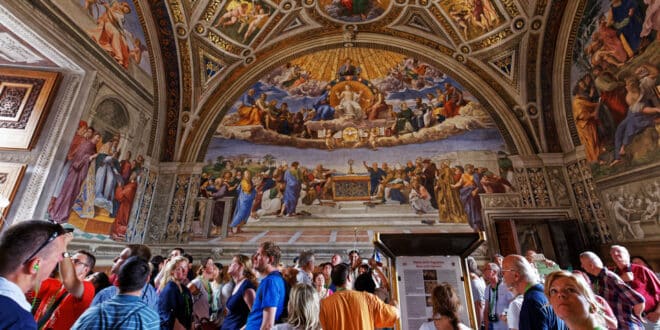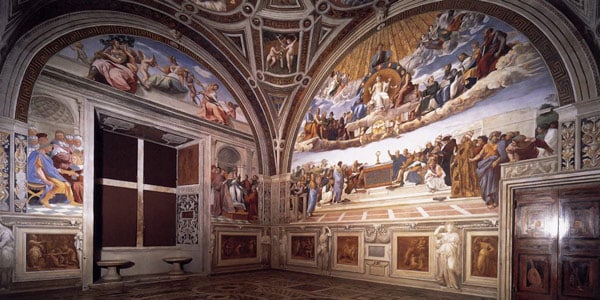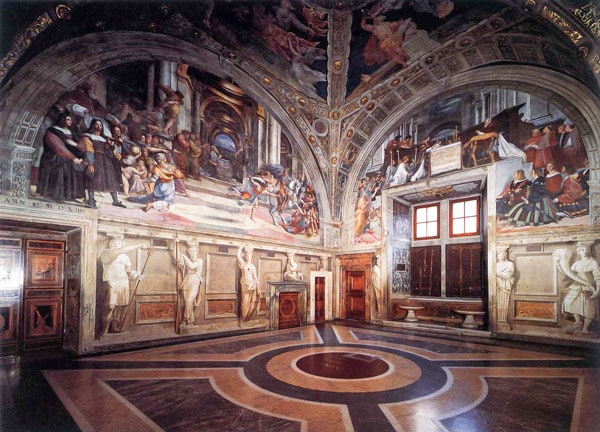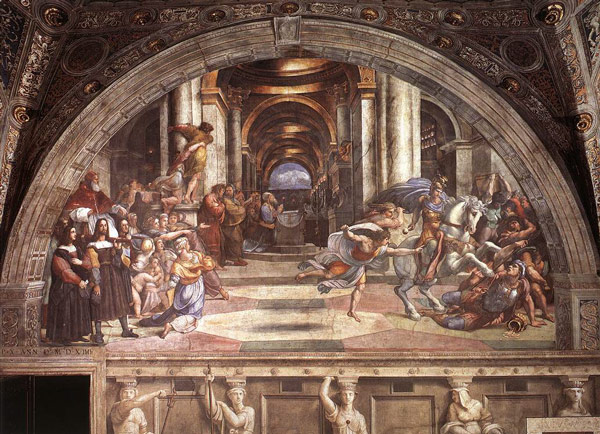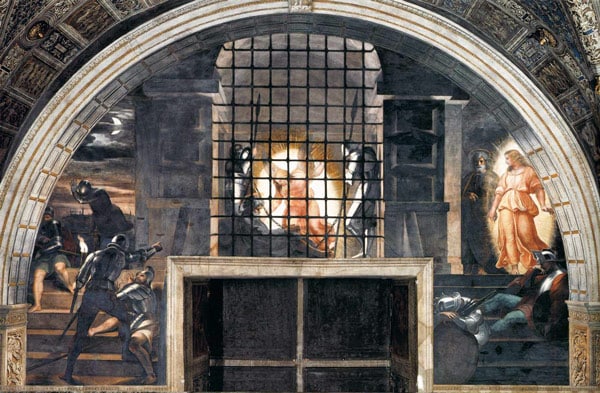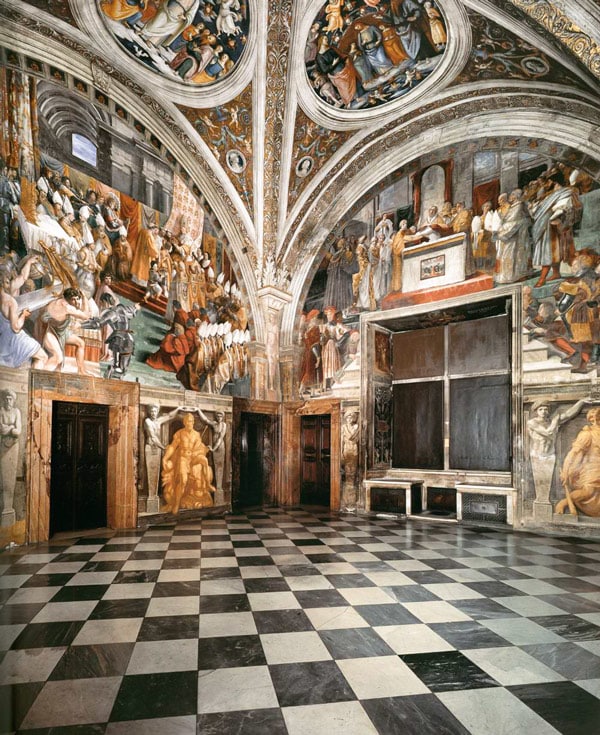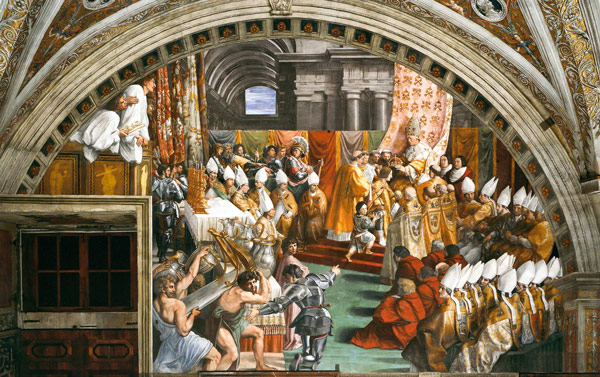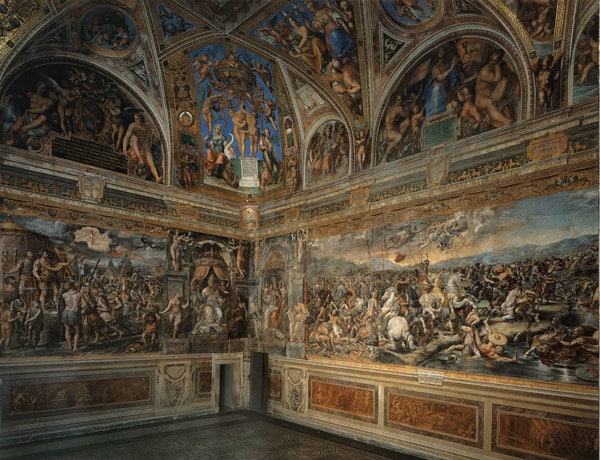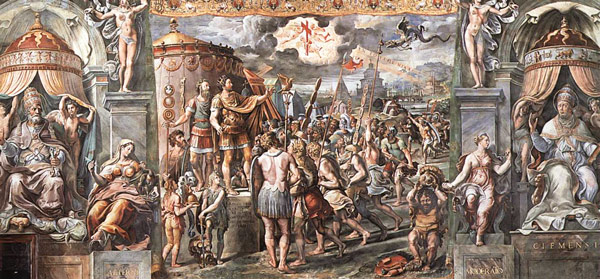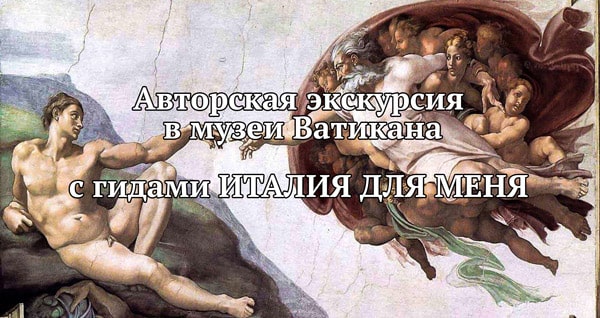The Raphael Rooms (Stanze di Raffaello) are part of the extensive museum complex in the Vatican (Città del Vaticano). The museum’s four relatively small rooms (approximately 6×8 meters each) are named after the great Renaissance artist Raphael Santi (Raffaello Santi) and his disciples, who painted them.
“Stanza” in Italian means “room”; starting with Pope Julius II, who didn’t want to live in the same quarters as the despised Alexander VI Borgia, these rooms served as the private papal apartments.
The frescoes by Raphael, adorning the walls and ceilings of the rooms, astonish visitors to the Vatican’s museum complex not only with their mastery, execution, harmony, and vivid colors but also with their narrative depth, attention to detail, profound meaning, and symbolism. Legend has it that the Pope was so impressed by the young artist’s work that he ordered the removal of the already completed images by other masters from the walls and entrusted all the painting work exclusively to Raphael.
Recommended reading: the Renaissance era in Italy.
Page Contents
Stanza della Segnatura
The first and most famous of the four rooms decorated by Raphael Santi in the Vatican is the Stanza della Segnatura. When the artist began painting it, he was just 25 years old, yet his youth did not prevent him from creating a true masterpiece.
The work on the Della Segnatura took three years – from 1508 to 1511. The room’s wall frescoes are dedicated to a single theme – human activity in the realm of spiritual achievements. The frescoes adorning the walls reflect four facets of such activity:
- Philosophy (“The School of Athens”)
- Theology (“Disputation of the Holy Sacrament”)
- Justice (“Cardinal and Theological Virtues”)
- Poetry (“The Parnassus”).
Only the Stanza della Segnatura has retained its original name and was not renamed after the themes of the main frescoes. Literally, the name can be translated as “the room of the signature” (from the Latin verb “signature” – to sign, mark, seal, or stamp). In this room, the Pope signed the documents sent to him.
“The School of Athens”
While all the frescoes adorning the Raphael Rooms are considered masterpieces, art historians and experts often herald “The School of Athens” (Scuola di Atene) in the Stanza della Segnatura as the finest. This fresco depicts a debate between two Greek philosophers – Aristotle and Plato. With an uplifted hand, Aristotle indicates that the world of human ideas is above earthly life; in contrast, Plato points to the earth as if to counter his colleague: the spiritual world is inextricably linked to the earthly realm.
Raphael also portrayed other famous philosophers: Diogenes, Pythagoras, Socrates, Heraclitus, Euclid, etc. Interestingly, some of them bear the features of Renaissance geniuses: Plato resembles Leonardo da Vinci, Heraclitus is easily identified as Michelangelo, and Euclid as Bramante. Raphael appears as one of the two youths conversing with Zoroaster and Ptolemy. According to the artist’s intent, this resemblance signifies the kinship and commonality of ideas between ancient Greek philosophy and the contemporary theology known to Raphael.
Stanza di Eliodoro (Room of Eliodoro)
From 1511 to 1514, Raphael worked on decorating a room named the Stanza di Eliodoro. The theme of the frescoes in this room is divine protection safeguarding the Church.
The Stanza di Eliodoro was named after the central piece of its pictorial composition. It was created based on the legend of the Syrian general Heliodorus, who was expelled from the temple in Jerusalem by a horse-riding angel.
The other two frescoes in Eliodoro are also dedicated to biblical and historical events where divine forces clearly intervened. “The Deliverance of Saint Peter from Prison” depicts the well-known biblical story of how an angel freed the apostle imprisoned in a dungeon.
Many see this as an allusion to the life story of Pope Leo X: in 1512, he was captured by the French but managed to escape.
The fresco “The Mass at Bolsena” is dedicated to the miracle that occurred in 1263: during the Eucharist, the host – a wafer intended for communion – suddenly began to bleed in the hands of a doubting priest.
Stanza dell’Incendio di Borgo (Room of the Fire in the Borgo)
The third room by Raphael and the last one he worked on himself, the Incendio di Borgo, was named after its eponymous fresco decorating one of the walls. The fresco is dedicated to a fire that engulfed the Borgo district adjacent to the Papal Palace in the Vatican. According to legend, Pope Leo IV managed to stop the fire and save the parishioners by blessing the panicked crowd with a miraculous cross.
The overall theme of the Incendio di Borgo’s frescoes is individual episodes from the history of papal deeds. This is the last room in the Vatican that Raphael painted himself. Work on it continued from 1514 to 1517. Raphael died in 1520, and his students continued the fresco work.
Sala di Costantino (Room of Constantine)
The Sala di Costantino is the last of the four rooms known as Raphael’s Stanze. The fresco in it is dedicated to the struggle of the Roman Emperor Constantine against the pagans. The story begins with the fresco “The Vision of the Cross,” depicting Constantine’s vision of a shining cross with the inscription “In this sign, conquer” before his battle against Maxentius at the Milvian Bridge.
The composition continues with frescoes dedicated to the battle against the pagans at the Milvian Bridge and the Christian rite of baptizing the emperor, concluding with the fresco “The Donation of Constantine,” dedicated to the emperor’s edict that, according to legend, granted the popes unlimited power over the Western Roman Empire.
Also, read about the Triumphal Arch of Constantine in Rome.
How to Visit the Vatican Museums
To view the Raphael Rooms, one must visit the Vatican Museums. Entry is through a single ticket that allows access to all exhibitions in the museum complex. The ticket costs 17 euros, with a reduced price of 8 euros for pensioners and students. Purchasing tickets online (see instructions) costs an additional 4 euros but saves time queuing.
 Italy for me From Italy with love
Italy for me From Italy with love

